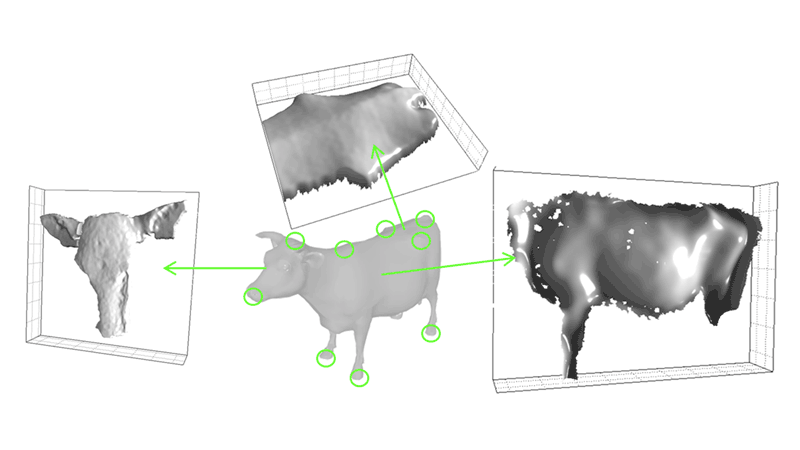by Andrea Pezzuolo, Luigi Sartori and Francesco Marinello (University of Padua, Italy)
Animal dimensions play a key role in providing data in support of management decisions regarding livestock production. In the last fifty years, manual measurements have been the most common way to get an indication of animal growth. An alternative approach, which overcomes the limitations of manual direct measurements, is to use techniques based on optical detection instruments.
Monitoring animal growth parameters in a frequent and quantitative way is useful to help the maintenance of animal health and to maximise production efficiency. In particular, the live weight is of great interest for breeding and management, as it serves as an index for animal growth, health and readiness for market.
Over the last fifty years, the best way to measure individual animal’s body live weight, as well as their physical development, has been through the use of traditional or electronic weighing systems. However, this approach is laborious and difficult, and it may be stressful for both the animals and the stockman. As a consequence, it can be very time consuming, expensive and may cause injury to the stockman [1].
An alternative approach, which overcomes the limitations of manual direct measurements, is with the introduction of techniques based on optical detection instruments. Optical systems are often used for agricultural and livestock study and applications. In different studies, different kinds of optical sensors (for example, 2D cameras) have been used, but there is a greater interest in 3D sensors, like TOF (Time-Of-Flight) camera or CTS (Consumer Triangulation Sensor) system [2].
Another important sensor that could be implemented is Microsoft Kinect™. Three-dimensional reconstruction by the Kinect camera is achieved by combining an infrared laser emission source with an infrared-sensitive camera. Since its launch in 2010, tens of millions of units of this sensor have been sold, and there is a growing interest in how its high quality three-dimensional imaging can be used in many applications including the agriculture and livestock sectors [3].
Some studies have already discussed the use of the Kinect sensor in livestock applications. However, there is a lack of information about metrological performance, and this is severely limiting the actual application of the method, since it is not clear to what extent Kinect 3D data can support or replace manual measurements, particularly when the animal’s body is in different positions.
The present study proposes the implementation of the same low-cost Kinect v1 depth camera for fast, non-contact measurements of cow (Figure 1) and pig (Figure 2) body dimensions such as heart girth, length and height. Such body values can be directly related to the weight which can be thus estimated without moving or contacting the animal.

Figure 1: The system was implemented in order to allow a fast extraction and monitoring of different cow body parameters and in particular heart girth, length and height.

Figure 2: Example of a portion of the animal back, as revealed by the top sensor before (A) and after (B) Gaussian filtering. Definition of the pig external profile (C) and localisation of the reference cross sections (D).
Research experiments compared estimated data with the results from manual measurements during the fattening period, highlighting relatively high coefficients of determination (R²>0.9), in particular for parameters arising from three-dimensional measurements collected on low-depth surfaces, as is the case of hip distance or withers to tail head length. Slightly lower accuracy is achieved when analyses are carried out on high aspect ratio body shapes or on purely three-dimensional shapes, as found in the cases of average height or chest girth data comparison (with an R²=0.7-0.9). The lowest performances are observed when parameter values are estimated as a combination of multiple parameters, due to uncertainty propagation: this has been shown in the cases of back slope or depth experiments (R²<0.5).
Furthermore, compared to manual measurements, the adoption of the Kinect sensor for the quantification of body parameters allows a significant reduction in the absolute error means. Indeed, compared to the use of manual measurements, the non-contact Kinect approach enables the collection of more data in a shorter time and is not affected by difficulties associated with ruler reading or uncertainties related to animal movements that are characteristic of slow manual measurement approaches.
The method clearly needs pre-industrialisation engineering activity to allow automatic data collection and extraction. Additionally, studies are needed in livestock environments to understand the effects of prolonged dust exposure on the Kinect infrared projector or sensor, and the presence of high vibration levels due to the frequent passage of tractors or other vehicles in the proximity of the device installation.
However, considering that livestock farms are generally increasing their stock densities, the possibility of replacing manual with non-contact measurements is of great interest in order to optimise herd management based on individual animal’s health, welfare and growth data monitoring, with no induced stress on animals.
References:
[1] A. Pezzuolo, et al.: “On-barn pig weight estimation based on body measurement by means of a Kinect v1 depth-camera”, Computers and Electronics in Agriculture, 148: 29-36, 2018..
[2 M. Dubbini, et al.: “Last generation instrument for agriculture multispectral data collection”, CIGR Journal, 19: 87-93, 2017.
[3] A. Pezzuolo, M. Guarino, L. Sartori, F. Marinello: “A feasibility study on the use of a structured light depth-camera for three-dimensional body measurements of dairy cows in free-stall barns”, Sensors, 18(2): 673, 2018.
Please contact:
Andrea Pezzuolo
Department of Agroforesty and Landscape, University of Padua - Italy.











